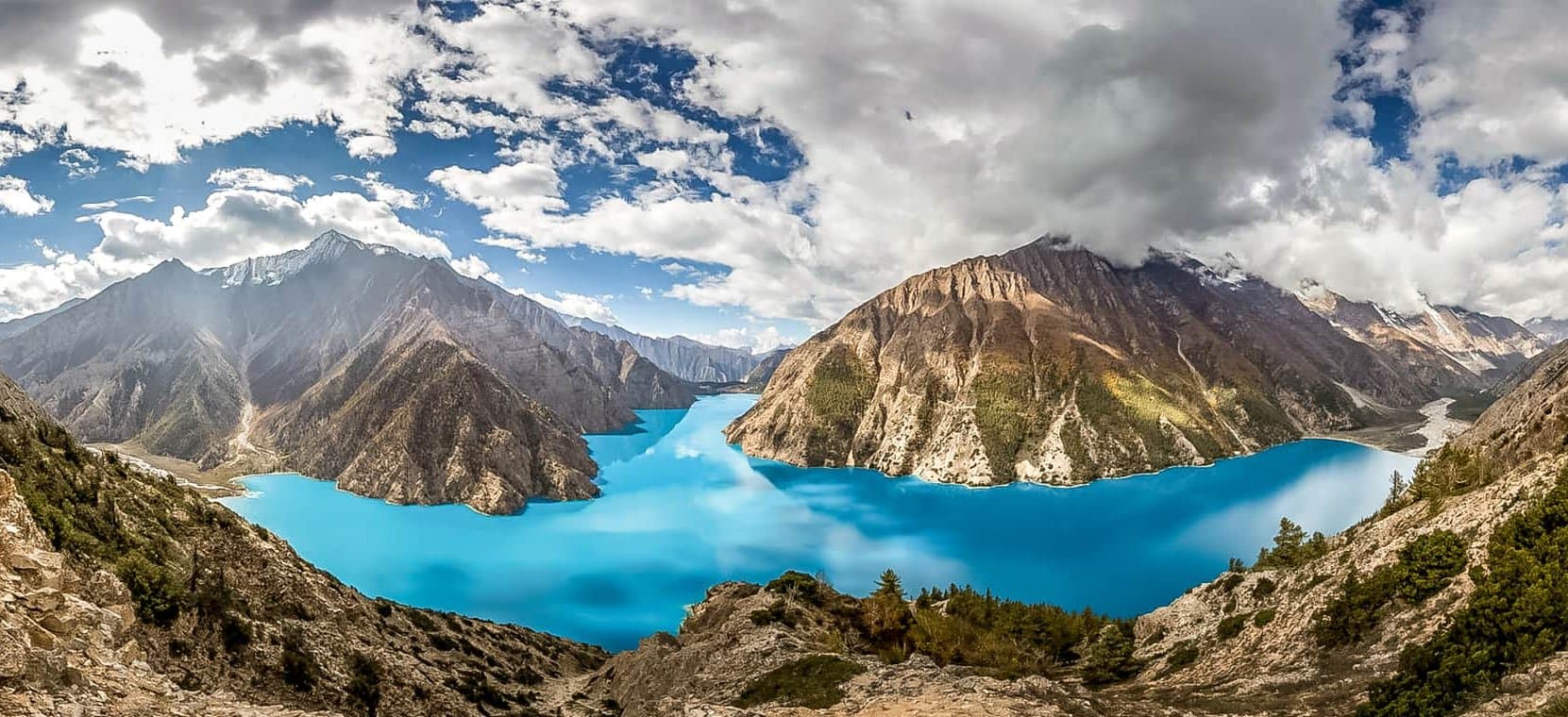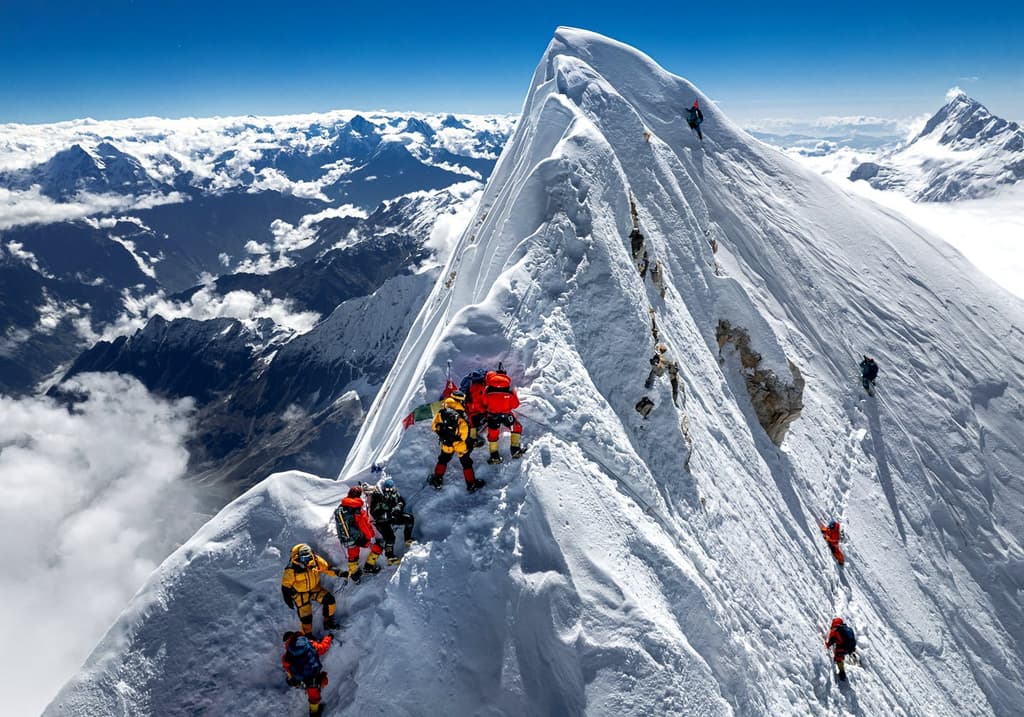Delve deeper into Nepal's hidden treasures with treks that venture beyond the iconic Everest, revealing the country's diverse tapestry of landscapes, cultures, and remote wilderness. These lesser-known paths offer adventurers the chance to explore towering mountains, lush valleys, and serene lakes, all while experiencing the rich traditions and warm hospitality of the local communities. From the challenging passes of the Manaslu Circuit to the sacred valleys of Tsum and the untouched beauty of Dolpo, each journey is a testament to Nepal's natural majesty and cultural depth. Immerse yourself in an unparalleled exploration where serene natural beauty and ancient traditions converge, offering a profound connection to the heart of the Himalayas.
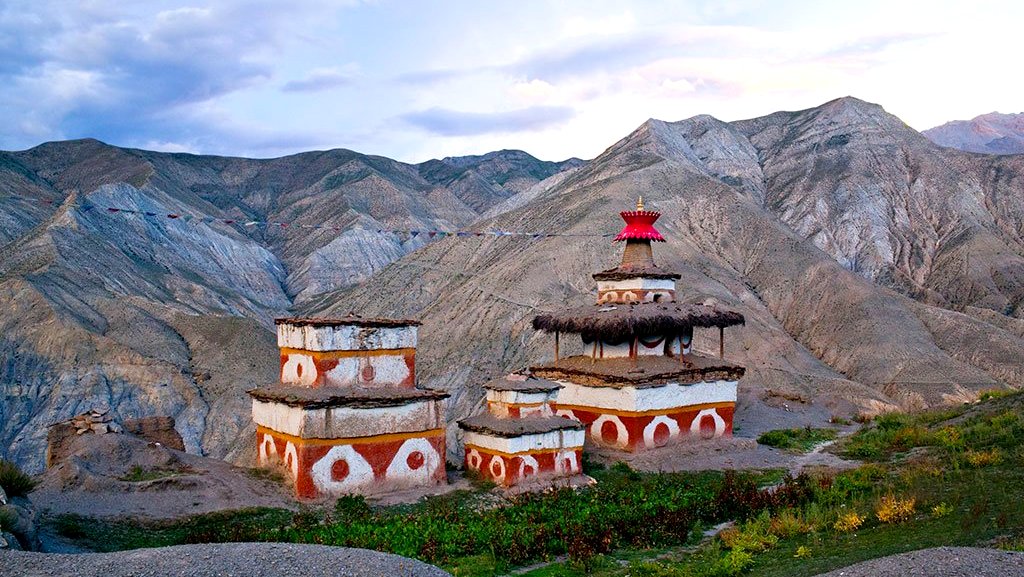
Luxury Holidays Nepal is your trusted partner for discovering the lesser-known treks beyond Everest. With a deep understanding of Nepal's vast landscapes and rich cultures, our team ensures every traveler experiences the unparalleled beauty and adventure of hidden Himalayan trails. Offering personalized itineraries, expert guides, and top-notch accommodations, we bring you closer to Nepal's untouched wonders. Whether it's the remote Manaslu Circuit, the mystical Upper Dolpo, or the serene Mardi Himal, our tailored treks are designed to provide an unforgettable journey through Nepal's most breathtaking and secluded paths. Trust Luxury Holidays Nepal for an exceptional trekking experience that goes beyond the ordinary.
Manaslu Circuit Trek
The Manaslu Circuit Trek is an exceptional journey around the world's eighth-highest mountain, Mount Manaslu, standing at an imposing height of 8,163 meters (26,781 feet). This trek is renowned for its breathtaking natural beauty, remote landscapes, and the opportunity to experience the rich cultural heritage of the Nepalese Himalayas. It presents a less crowded but equally rewarding alternative to the more popular treks in Nepal, offering a blend of adventure, solitude, and cultural immersion.

Highlights of the Manaslu Circuit Trek:
-
Stunning Scenery: The trek provides panoramic views of Mount Manaslu, along with a range of other Himalayan giants. The trail winds through lush forests, alpine meadows, and high-altitude landscapes, offering a diversity of vistas.
-
Rich Cultural Experience: Trekkers pass through traditional villages where they can experience the daily lives of the local inhabitants, mainly of Tibetan origin. The region is dotted with ancient Buddhist monasteries, chortens, and mani walls, adding a spiritual dimension to the journey.
-
Larkya La Pass: Crossing the Larkya La Pass, at an elevation of 5,106 meters (16,752 feet), is a highlight and also the most challenging part of the trek. It offers stunning views of the surrounding peaks and glaciers.
-
Diverse Flora and Fauna: The trek traverses through the Manaslu Conservation Area, home to a rich array of flora and fauna. Trekkers might spot Himalayan Tahr, Blue Sheep, Pika, and even the elusive Snow Leopard.
-
Remote and Peaceful Trails: The Manaslu Circuit remains less trodden compared to Everest Base Camp or the Annapurna Circuit, offering a more peaceful trekking experience. It's an opportunity to enjoy the pristine beauty of the Himalayas in relative solitude.
Trek Details:
- Duration: Typically, the trek takes about 14 to 16 days, depending on the pace and the chosen itinerary.
- Difficulty Level: The trek is considered challenging due to its duration, the high altitudes, and the crossing of Larkya La Pass. It requires good physical fitness and acclimatization to high altitudes.
- Best Season: The best times to undertake the Manaslu Circuit Trek are during the spring (March to May) and autumn (September to November) seasons when the weather is most favorable, and the views are clear.
Preparation and Permits:
Preparation for the Manaslu Circuit Trek should include physical training, acquiring proper gear, and understanding the risks associated with high-altitude trekking. Trekkers need several permits for the trek, including the Manaslu Conservation Area Permit (MCAP), the Annapurna Conservation Area Permit (ACAP), and a restricted area permit for Manaslu, all of which are usually arranged by trekking agencies.
The Manaslu Circuit Trek is an adventure that promises not just the thrill of Himalayan trekking but also a deep dive into the cultural heartland of Nepal, making it a memorable experience for those who choose to explore it.
Kanchenjunga Base Camp Trek
The Kanchenjunga Base Camp Trek is a spectacular journey to the foothills of the world's third-highest peak, Mount Kanchenjunga, which stands majestically at 8,586 meters (28,169 feet). This trek is for those who seek solitude and the thrill of exploring one of the most remote regions in the Himalayas. It's a challenging adventure that rewards trekkers with stunning landscapes, diverse ecosystems, and insights into the rich cultural traditions of eastern Nepal.

Highlights of the Kanchenjunga Base Camp Trek:
- Diverse Landscapes: The trek traverses through lush tropical forests, verdant rhododendron forests, and high alpine zones, offering a wide range of biodiversity and scenic beauty.
- Spectacular Mountain Views: Trekkers are treated to breathtaking views of not just Mount Kanchenjunga, but also other Himalayan giants like Mount Makalu, the world's fifth highest mountain, and a host of other peaks that border Nepal and Sikkim, India.
- Rich Biodiversity: The route passes through the Kanchenjunga Conservation Area, which is home to diverse flora and fauna, including snow leopards, red pandas, and Himalayan black bears, among others.
- Cultural Insights: The trek provides a unique opportunity to experience the lifestyle and traditions of the local Limbu, Sherpa, and Rai communities, offering a glimpse into their daily lives, culture, and religion.
- Solitude and Serenity: Being one of the less frequented treks in Nepal, the Kanchenjunga Base Camp Trek offers a sense of solitude and serenity that is hard to find in more popular trekking routes.
Trek Details:
- Duration: The trek typically takes about 20 to 25 days, depending on the chosen route and pace.
- Difficulty Level: This trek is considered strenuous due to its length, the remote terrain, and the high altitudes that trekkers must acclimatize to. It requires excellent physical fitness and prior trekking experience.
- Best Season: The best times to embark on this trek are during the spring (March to May) and autumn (September to November) seasons when the weather is clear and stable.
Preparation and Permits:
Trekkers need to be well-prepared for the Kanchenjunga Base Camp Trek, with appropriate gear, physical conditioning, and knowledge of high-altitude trekking. Several permits are required for this trek, including a Kanchenjunga Conservation Area Permit and a restricted area permit, as parts of the trek go through areas that are protected and regulated by the Nepalese government.
The Kanchenjunga Base Camp Trek is an unparalleled adventure that offers an intimate experience with the natural and cultural richness of the Himalayas. It's a journey that challenges and rewards in equal measure, providing memories that last a lifetime.
Annapurna Base Camp Trek
The Annapurna Base Camp Trek is one of Nepal's most famous and accessible high-mountain adventures, offering an extraordinary variety of landscapes, a range of cultural experiences, and the spectacular panorama of the Annapurna massif. This trek takes you through the heart of the Annapurna region, providing a blend of majestic mountain views, lush rhododendron forests, and a close-up experience of local Gurung and Magar cultures.
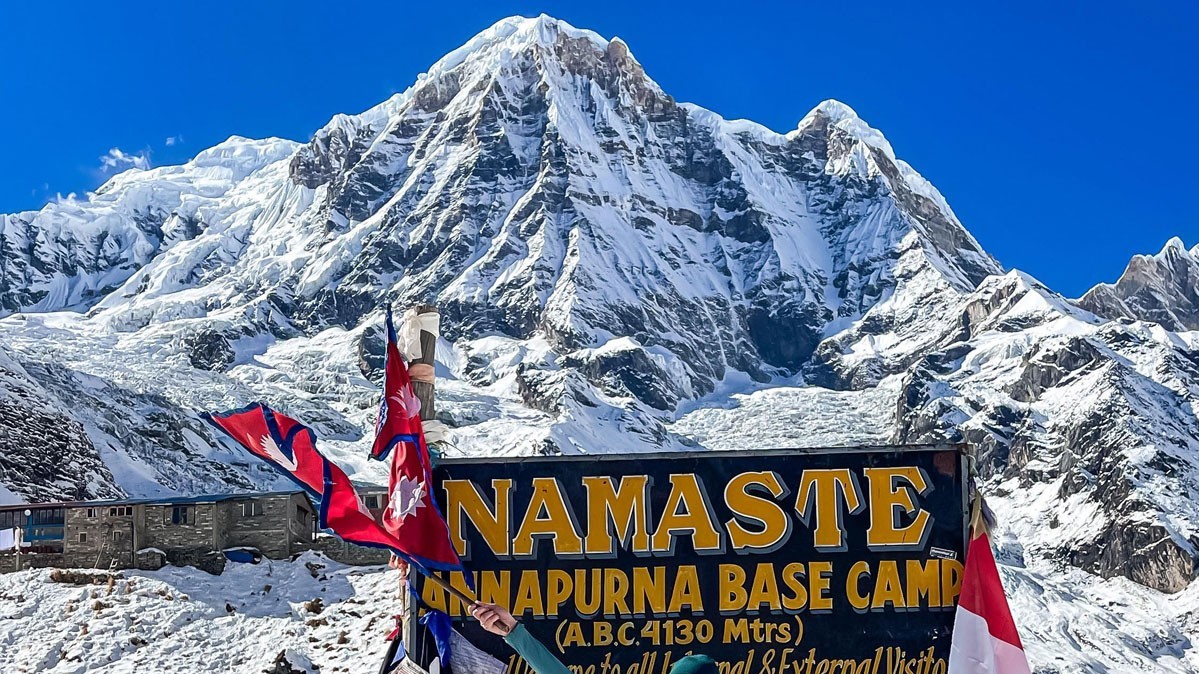
Highlights of the Annapurna Base Camp Trek:
- Diverse Landscapes: The trek navigates through a variety of terrains, from lowland villages and terraced rice fields to high-altitude landscapes and glacial basins surrounded by the towering Himalayas.
- Spectacular Mountain Views: Offers up-close views of several high peaks, including Annapurna I (8,091m), Annapurna South (7,219m), Machapuchare (6,993m), and Hiunchuli (6,441m).
- Machapuchare Base Camp: Before reaching Annapurna Base Camp, trekkers pass through Machapuchare Base Camp, which offers stunning views of the fishtail-shaped Machapuchare Mountain.
- Annapurna Sanctuary: The trek culminates at the Annapurna Base Camp, located in the Annapurna Sanctuary, a natural amphitheater surrounded by 360-degree views of high Himalayan peaks.
- Cultural Experience: The trail passes through traditional Gurung and Magar villages, offering insights into the lifestyle, culture, and traditions of these ethnic groups.
Trek Details:
- Duration: The trek can be completed in 7 to 12 days, depending on the starting point, trekking pace, and any side trips.
- Difficulty Level: It is considered moderate; while it does not require technical climbing, the trek involves several days of walking at high altitudes and some steep ascents and descents.
- Best Season: The best seasons for the Annapurna Base Camp Trek are spring (March to May) and autumn (September to November), when the weather is clear, and the mountain views are at their best.
Preparation and Permits:
Preparation should include physical conditioning, packing appropriate gear for a variety of weather conditions, and acclimatizing to higher altitudes to avoid acute mountain sickness (AMS). Trekkers need an Annapurna Conservation Area Permit (ACAP) and a Trekkers’ Information Management System (TIMS) card. These can be arranged through trekking agencies or at the Nepal Tourism Board office in Kathmandu or Pokhara.
The Annapurna Base Camp Trek is an unforgettable journey into the heart of the Himalayas, offering a remarkable mix of natural beauty, cultural richness, and trekking challenges. It's an excellent choice for both novice and experienced trekkers seeking the majesty of Nepal’s mountain landscapes and the warmth of its people.
Mardi Himal Trek
The Mardi Himal Trek is a hidden gem in the Annapurna region of Nepal, offering a relatively short and spectacular journey into the pristine landscapes of the Himalayas. This trek has gained popularity for its scenic beauty, serene trails, and close-up views of the Annapurna range, including Machapuchare (Fishtail Mountain), Annapurna South, and Hiunchuli. It's an ideal choice for those looking to escape the more crowded trails and experience the tranquility and majesty of the Himalayas in a more intimate setting.

Highlights of the Mardi Himal Trek:
- Serene and Less Crowded Trails: Compared to the more popular Annapurna Base Camp or Poon Hill treks, Mardi Himal offers a peaceful trekking experience with fewer trekkers on the trail.
- Spectacular Mountain Views: The trek provides stunning, up-close views of Machapuchare, Annapurna South, Hiunchuli, and other peaks of the Annapurna range. The viewpoint from Mardi Himal Base Camp is particularly breathtaking.
- Diverse Terrain: The trail winds through lush rhododendron forests, alpine meadows, and high-altitude landscapes, showcasing the ecological diversity of the Annapurna Conservation Area.
- Rich Flora and Fauna: The forests along the Mardi Himal trek are a habitat for a variety of bird species, making it a delight for bird watchers. The area's rich biodiversity includes rhododendrons and other alpine flora.
- Cultural Insights: Trekking through the small villages and hamlets offers insights into the lifestyle and culture of the Gurung people living in the Annapurna region.
Trek Details:
- Duration: The trek can typically be completed in 5 to 7 days, making it a perfect option for those with limited time but a desire to experience high-mountain trekking.
- Difficulty Level: It is considered moderate; the trails are less developed than those of more popular treks, and there are steep sections that require a good level of fitness.
- Best Season: The best times to undertake the Mardi Himal Trek are during the spring (March to May) and autumn (September to November) when the weather is clear, and the views are most spectacular.
Preparation and Permits:
Preparation for the Mardi Himal Trek involves physical conditioning, packing appropriate gear for variable weather conditions, and being prepared for basic lodging facilities as the trek is more off-the-beaten path. Trekkers need an Annapurna Conservation Area Permit (ACAP) and a Trekkers’ Information Management System (TIMS) card.
The Mardi Himal Trek is a captivating journey that offers trekkers an intimate experience with the natural beauty and cultural richness of the Annapurna region. Its relatively short duration, combined with the stunning landscapes and peaceful trails, makes it an excellent choice for those looking to delve into the heart of the Himalayas without venturing onto the more crowded paths.
Upper Dolpo Trek
The Upper Dolpo Trek is a remarkable journey into one of the most remote and unspoiled regions of the Nepalese Himalayas. Situated in the northwestern part of Nepal, bordering Tibet, Upper Dolpo remains a bastion of Tibetan Buddhism and is known for its high-altitude terrain, deep valleys, and ancient culture. This trek offers an unparalleled glimpse into the life and landscape of one of the last truly isolated areas on earth, providing a unique blend of adventure and cultural immersion.
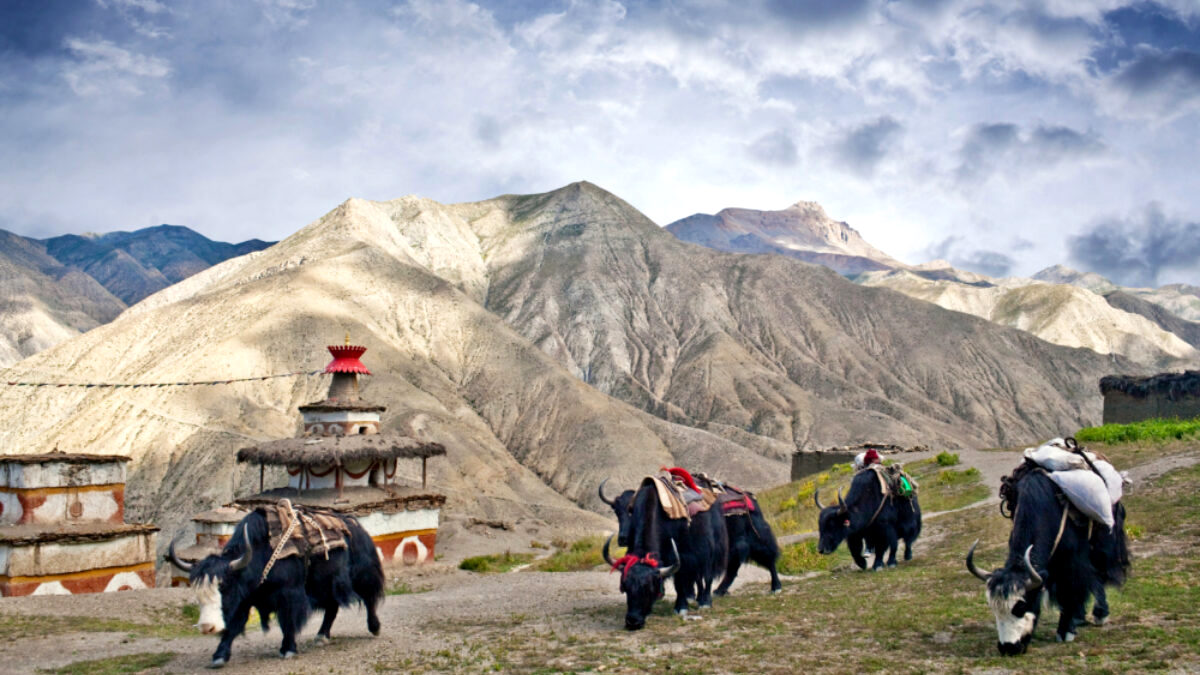
Highlights of the Upper Dolpo Trek:
- Shey Phoksundo Lake: The trek features a visit to the stunning Shey Phoksundo Lake, Nepal's deepest and second-largest lake. Its turquoise waters set against a backdrop of rugged cliffs and forests create a mesmerizing sight.
- Tibetan Buddhist Culture: Upper Dolpo is a stronghold of traditional Tibetan Buddhism, evident in the ancient monasteries, chortens, and prayer flags that dot the landscape. The region's most famous monastery, Shey Gompa, is often referred to as the spiritual heart of Dolpo.
- Remote and Pristine Landscapes: The trek traverses through isolated valleys, high passes, and rugged terrain, offering breathtaking views of the untouched wilderness. The area's isolation has preserved its natural beauty and traditional way of life.
- Rare Wildlife: The region is part of the Shey Phoksundo National Park, home to rare species like the snow leopard, blue sheep, and the Himalayan tahr.
- Ancient Trade Routes: Upper Dolpo has been a crucial part of ancient trade routes between Tibet and Nepal, and the trek offers insights into the history and culture shaped by these interactions.
Trek Details:
- Duration: The Upper Dolpo Trek typically takes about 18 to 28 days, depending on the chosen route and pace.
- Difficulty Level: It is considered challenging due to its remote location, high altitude passes, and the lack of modern facilities. This trek requires excellent physical fitness and previous trekking experience in high-altitude environments.
- Best Season: The ideal times to embark on this trek are during the spring (May to June) and autumn (September to November) seasons, when the weather is most stable and the passes are clear.
Preparation and Permits:
Trekking to Upper Dolpo requires thorough preparation, including physical conditioning, packing appropriate gear for extreme weather, and arranging logistics for food and accommodation, as the facilities are basic and far between. Trekkers need to obtain a special restricted area permit for Upper Dolpo, in addition to the Shey Phoksundo National Park entry permit and the Trekkers’ Information Management System (TIMS) card.
The Upper Dolpo Trek is an expedition into a world preserved by its isolation, offering a rare opportunity to experience the grandeur of the Himalayas and the timeless culture of its inhabitants. It's an adventure suited for those who seek to explore the less traveled paths and delve deep into the heart of one of the most mystical regions on the planet.
Langtang Valley Trek
The Langtang Valley Trek is a mesmerizing journey to the heart of the Himalayas, located just north of Kathmandu. This trek offers an incredible mix of natural beauty, cultural richness, and relative ease of access, making it a perfect choice for those looking to experience the majesty of the Himalayas without venturing too far from the capital. The trek takes you through the beautiful Langtang National Park, home to diverse flora and fauna, and offers stunning views of Langtang Lirung, Langtang Ri, and other Himalayan peaks.

Highlights of the Langtang Valley Trek:
- Scenic Landscapes: The trek provides a spectacular showcase of biodiversity, from lush forests of oak, maple, and rhododendron to rugged rock and ice formations at higher altitudes.
- Rich Cultural Experience: The valley is home to the Tamang people, whose customs and traditions are heavily influenced by Tibetan culture. Trekkers can explore ancient monasteries and llearn about the local way of life.
- Kyanjin Gompa: A significant highlight is the village of Kyanjin Gompa, where trekkers can visit a local monastery and a cheese factory, set against the backdrop of the towering Himalayas.
- Diverse Wildlife: Langtang National Park is a habitat for several species of wildlife, including the red panda, Himalayan tahr, and various bird species, mlaking it a delight for nature enthusiasts.
- Accessibility: One of the most appealing aspects of the Langtang Valley Trek is its accessibility. It's possible to reach the starting point of the trek, Syabrubesi, with just a day's drive from Kathmandu.
Trek Details:
- Duration: The trek can typically be completed in 7 to 9 days, making it an excellent option for those with limited time.
- Difficulty Level: The trek is considered moderate, suitable for beginners and experienced trekkers alike. While it involves some steep ascents, the overall altitude gain is gradual, reducing the risk of altitude sickness.
- Best Season: The best times to undertake the Langtang Valley Trek are during the spring (March to May) and autumn (September to November) when the weather is clear and the views are most spectacular.
Preparation and Permits:
Preparation for the Langtang Valley Trek should include physical conditioning, packing appropriate clothing and gear for variable weather conditions, and planning for basic teahouse accommodations along the route. Trekkers need to obtain a Langtang National Park permit and a Trekkers’ Information Management System (TIMS) card.
The Langtang Valley Trek is an unforgettable journey that combines natural beauty, cultural encounters, and the adventure of Himalayan trekking. Its accessibility, diverse attractions, and the warmth of the local people make it a highly recommended experience for anyone looking to explore the Himalayas.
Tsum Valley Trek
The Tsum Valley Trek is a captivating journey into one of the most remote and sacred Himalayan valleys in Nepal. Located in the northern part of the country, adjacent to the Manaslu region, the Tsum Valley is renowned for its outstanding natural beauty, rich cultural heritage, and spiritual significance. This trek offers a rare opportunity to explore the untouched landscapes and ancient traditions of the Tsum people, who have lived in harmony with their environment for centuries.

Highlights of the Tsum Valley Trek:
- Secluded and Pristine Environment: The Tsum Valley, often referred to as the "hidden valley," remains one of the least explored regions in Nepal, offering trekkers a sense of discovery and adventure.
- Rich Buddhist Culture: The valley is dotted with ancient monasteries, chortens, and mani walls, reflecting the strong Tibetan Buddhist influence. The famous Mu Gompa and Rachen Gompa are must-visit sites, providing insights into the spiritual lifestyle of the locals.
- Panoramic Mountain Views: Trekkers are treated to stunning views of the Ganesh Himal, Sringi Himal, and Boudha Himal ranges. The valley's landscapes are a mesmerizing mix of rugged terrain, sprawling pastures, and serene river valleys.
- Unique Biodiversity: The Tsum Valley is home to diverse flora and fauna, including some species that are rare or endemic to the region. The area's conservation efforts help preserve its natural ecosystems.
- Cultural Immersion: The trek offers a profound cultural experience, as visitors get to witness the daily lives, festivals, and traditional practices of the Tsum people, whose customs have remained largely unchanged for generations.
Trek Details:
- Duration: The trek typically takes about 18 to 21 days, depending on the itinerary and pace. Some trekkers choose to combine it with the Manaslu Circuit for a more extended adventure.
- Difficulty Level: The trek is considered moderate to challenging, mainly due to its duration and the remote terrain. While it doesn't require technical skills, good physical fitness and stamina are essential.
- Best Season: The ideal times to undertake the Tsum Valley Trek are during the spring (March to May) and autumn (September to November) seasons, when the weather is clear, and the mountain views are most vivid.
Preparation and Permits:
Preparing for the Tsum Valley Trek involves physical training, securing the right gear for varying weather conditions, and understanding the basics of high-altitude trekking. Trekkers need a special restricted area permit for the Tsum Valley, in addition to the Manaslu Conservation Area Permit (MCAP) and the Annapurna Conservation Area Permit (ACAP), if combining with the Manaslu Circuit. A Trekkers’ Information Management System (TIMS) card is also required.
The Tsum Valley Trek is an extraordinary journey that not only challenges the body but also enriches the soul. It's an invitation to explore the untouched beauty of the Himalayas, immerse oneself in the depth of Tibetan Buddhism, and witness the sustainable lifestyle of the Tsum people.
Tips for the Beyond Everest: Unveiling Nepal's Lesser-Known Treks
Embarking on treks beyond the well-trodden paths to Everest can be a profoundly rewarding experience, offering solitude, unspoiled natural beauty, and a deeper connection with the local cultures of Nepal. To make the most of these lesser-known treks, here are some tips to ensure a safe, enjoyable, and enriching journey:
- Choose the Right Trek for Your Experience Level: Assess your physical fitness, trekking experience, and comfort with high-altitude conditions. Some treks, like the Upper Dolpo or Kanchenjunga Base Camp, are more challenging and require previous trekking experience.
- Research and Plan Thoroughly: Research your chosen trek thoroughly, including the best times to go, what permits you need, and what to expect in terms of weather and trail conditions. Detailed planning helps in managing expectations and preparing for the journey ahead.
- Hire a Local Guide or Join a Guided Tour: Employing a local guide or joining a guided trek can enhance your experience significantly. Guides provide invaluable insights into the local culture, help navigate challenging terrains, and contribute to the local economy.
- Acclimatize Properly to Avoid Altitude Sickness: Allow your body to adjust to higher altitudes gradually. Plan for adequate rest days in your itinerary, especially on treks that ascend above 3,000 meters. Understanding the signs of altitude sickness and how to respond is crucial.
- Pack Wisely: Pack light but ensure you have all the essentials, including layers for variable weather conditions, a good quality sleeping bag, a first-aid kit, and necessary trekking gear. Don't forget to bring a water purification method.
- Respect Local Traditions and Customs: The remote regions of Nepal are home to diverse cultures and traditions. Show respect by dressing modestly, asking permission before taking photos, and being mindful of local customs, especially when visiting monasteries and religious sites.
- Leave No Trace: Practice sustainable trekking by carrying out all your trash, minimizing plastic use, and staying on established trails to reduce environmental impact.
- Prepare for Limited Connectivity: Many of these remote treks have limited to no internet or mobile connectivity. Prepare to be off-grid, which can be a refreshing experience, but ensure you have a way to communicate in case of emergencies.
- Invest in Good Insurance: Make sure you have comprehensive travel insurance that covers high-altitude trekking, medical evacuation, and any other activities you plan to undertake.
- Embrace the Journey: Finally, keep an open mind and be flexible. Part of the adventure is dealing with the unexpected. Embrace the challenges and the beauty of the journey.
Exploring Nepal's lesser-known treks offers an unparalleled opportunity to connect with nature and local cultures more intimately and sustainably. With the right preparation and mindset, these treks can provide some of the most memorable and transformative experiences for the adventurous traveler.
Exploring the lesser-known treks beyond Everest in Nepal unveils a world brimming with untamed beauty, deep cultural immersion, and the serenity of remote Himalayan paths. These journeys offer adventurers a unique blend of challenges and rewards, presenting the pristine landscapes, rich traditions, and vibrant communities that lie hidden from the well-trodden trails. Whether it's the rugged terrain of the Upper Dolpo, the sacred valleys of Tsum, or the serene beauty of the Langtang region, each trek is a testament to Nepal's unparalleled diversity and the spirit of exploration. As trekkers seek paths less traveled, they not only discover the natural and cultural treasures of Nepal but also contribute to the preservation and appreciation of these remote regions. In stepping beyond Everest's shadow, adventurers open themselves to experiences that redefine the essence of trekking in the Himalayas, fostering a deeper connection with the natural world and the resilient communities that call it home.
FAQs of the Beyond Everest: Unveiling Nepal's Lesser-Known Treks
Q: What makes these lesser-known treks different from the Everest Base Camp trek?
A: These treks offer a more secluded experience, allowing trekkers to immerse themselves in untouched natural beauty and engage more deeply with local cultures. They often feature challenging terrains and higher altitudes but with fewer tourists, providing a more authentic adventure.
Q: Are these treks suitable for beginners?
A: While some treks like the Langtang Valley and Mardi Himal are suitable for beginners due to their moderate difficulty levels, others such as the Upper Dolpo or Kanchenjunga Base Camp Treks require good physical fitness, previous trekking experience, and a high level of endurance.
Q: What is the best time of year to go on these treks?
A: The best time to embark on these treks is during the spring (March to May) and autumn (September to November) seasons. These periods offer stable weather, clear skies, and the best views of the Himalayas.
Q: Do I need a guide for these treks?
A: Hiring a local guide is highly recommended, especially for the more remote and challenging treks. Guides provide valuable insights, ensure your safety, and help navigate difficult terrains.
Q: What permits do I need?
A: Most of these treks require specific permits, such as the Annapurna Conservation Area Permit (ACAP), Manaslu Conservation Area Permit (MCAP), or special restricted area permits for regions like Upper Dolpo and Kanchenjunga. A Trekkers’ Information Management System (TIMS) card is also usually necessary.
Q: How should I prepare for high altitude?
A: Acclimatize properly by allowing several days for your body to adjust to the altitude, especially if trekking above 3,000 meters. Recognize the symptoms of altitude sickness and know when to descend to a lower altitude if needed.
Q: What kind of accommodation can I expect?
A: Accommodations vary from basic teahouses offering the essentials to camping in the more remote areas. Facilities are generally simpler than those found on more popular treks.
Q: How can I minimize my environmental impact?
A: Practice Leave No Trace principles: pack out what you pack in, stay on marked trails, use biodegradable soap, and avoid single-use plastics. Supporting local businesses along the way also helps sustain the communities.
Q: What gear do I need?
A: Essential gear includes a good quality backpack, sleeping bag, layers for changing weather, waterproof clothing, trekking boots, a first-aid kit, and water purification solutions. Gear needs may vary based on the trek's duration and difficulty.
Q: Can I trek solo?
A: While solo trekking is possible on some routes, it's not recommended for the more remote or challenging treks. For safety reasons and to enhance your experience, consider hiring a guide or joining a group.
If you need any further information, please contact us by email: [email protected], Phone: +977- 985 100 5129 (WhatsApp)

